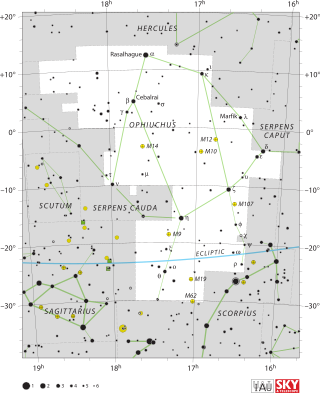
Ophiuchus is a large constellation straddling the celestial equator. Its name comes from the Ancient Greek ὀφιοῦχος (ophioûkhos), meaning "serpent-bearer", and it is commonly represented as a man grasping a snake. The serpent is represented by the constellation Serpens. Ophiuchus was one of the 48 constellations listed by the 2nd-century astronomer Ptolemy, and it remains one of the 88 modern constellations. An old alternative name for the constellation was Serpentarius.

Star formation is the process by which dense regions within molecular clouds in interstellar space, sometimes referred to as "stellar nurseries" or "star-forming regions", collapse and form stars. As a branch of astronomy, star formation includes the study of the interstellar medium (ISM) and giant molecular clouds (GMC) as precursors to the star formation process, and the study of protostars and young stellar objects as its immediate products. It is closely related to planet formation, another branch of astronomy. Star formation theory, as well as accounting for the formation of a single star, must also account for the statistics of binary stars and the initial mass function. Most stars do not form in isolation but as part of a group of stars referred as star clusters or stellar associations.
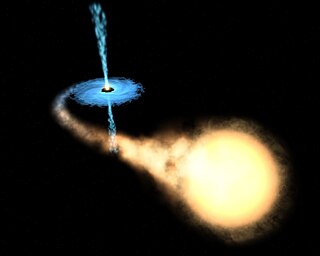
X-ray binaries are a class of binary stars that are luminous in X-rays. The X-rays are produced by matter falling from one component, called the donor, to the other component, called the accretor, which is either a neutron star or black hole. The infalling matter releases gravitational potential energy, up to 30 percent of its rest mass, as X-rays. The lifetime and the mass-transfer rate in an X-ray binary depends on the evolutionary status of the donor star, the mass ratio between the stellar components, and their orbital separation.

A stellar black hole is a black hole formed by the gravitational collapse of a star. They have masses ranging from about 5 to several tens of solar masses. They are the remnants of supernova explosions, which may be observed as a type of gamma ray burst. These black holes are also referred to as collapsars.

NGC 300 (also known as Baldwell 70 or the Sculptor Pinwheel Galaxy) is a spiral galaxy in the constellation Sculptor. It was discovered on 5 August 1826 by Scottish astronomer James Dunlop. It is one of the closest galaxies to the Local Group, and it most likely lies between the latter and the Sculptor Group. It is the brightest of the five main spirals in the direction of the Sculptor Group. It is inclined at an angle of 42° when viewed from Earth and shares many characteristics of the Triangulum Galaxy. It is 94,000 light-years in diameter, somewhat smaller than the Milky Way, and has an estimated mass of (2.9 ± 0.2) × 1010M☉.
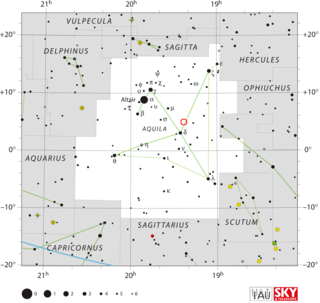
V1494 Aquilae or Nova Aquilae 1999 b was a nova which occurred during 1999 in the constellation Aquila and reached a brightness of magnitude 3.9 on 2 December 1999. making it easily visible to the naked eye. The nova was discovered with 14×100 binoculars by Alfredo Pereira of Cabo da Roca, Portugal at 18:50 UT on 1 December 1999, when it had a visual magnitude of 6.0.

NGC 663 is a young open cluster in the constellation of Cassiopeia. It has an estimated 400 stars and spans about a quarter of a degree across the sky. It can reportedly be detected with the unaided eye, although a telescope is recommended for best viewing. The brightest members of the cluster can be viewed with binoculars. Although the listed visual magnitude is 7.1, several observers have reported higher estimates.
The Tolman–Oppenheimer–Volkoff limit is an upper bound to the mass of cold, non-rotating neutron stars, analogous to the Chandrasekhar limit for white dwarf stars. Stars more massive than the TOV limit collapse into a black hole. The original calculation in 1939, which neglected complications such as nuclear forces between neutrons, placed this limit at approximately 0.7 solar masses (M☉). Later, more refined analyses have resulted in larger values.

GRO J1655−40 is a binary star consisting of an evolved F-type primary star and a massive, unseen companion, which orbit each other once every 2.6 days in the constellation of Scorpius. Gas from the surface of the visible star is accreted onto the dark companion, which appears to be a stellar black hole with several times the mass of the Sun. The optical companion of this low-mass X-ray binary is a subgiant F star.
The gamma-ray and X-ray source GRS 1124-683, discovered by the Granat mission and Ginga, is a system containing a black hole candidate. The system also goes by the name X-ray Nova Muscae 1991 or GU Muscae. These two orbiting X-ray telescopes discovered the system when the system produced an outburst of X-rays on January 9, 1991.

GRS 1915+105 or V1487 Aquilae is an X-ray binary star system containing a main sequence star and a black hole. Transfer of material from the star to the black hole generates a relativistic jet, making this a microquasar system. The jet exhibits apparent superluminal motion.
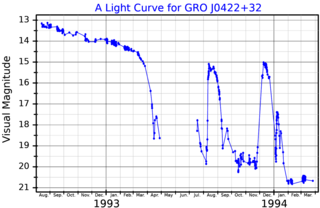
GRO J0422+32 is an X-ray nova and black hole candidate that was discovered by the BATSE instrument on the Compton Gamma Ray Observatory satellite on 5 August 1992. During outburst, it was observed to be stronger than the Crab Nebula gamma-ray source out to photon energies of about 500 keV.

V404 Cygni is a microquasar and a binary system in the constellation of Cygnus. It contains a black hole with a mass of about 9 M☉ and an early K giant star companion with a mass slightly smaller than the Sun. The star and the black hole orbit each other every 6.47129 days at fairly close range. Due to their proximity and the intense gravity of the black hole, the companion star loses mass to an accretion disk around the black hole and ultimately to the black hole itself.

Rho Ophiuchi is a multiple star system in the constellation Ophiuchus. The central system has an apparent magnitude of 4.63. Based on the central system's parallax of 9.03 mas, it is located about 360 light-years away. The other stars in the system are slightly farther away.
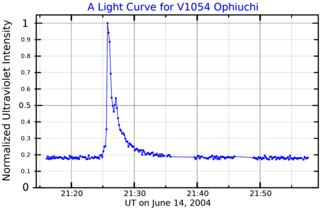
V1054 Ophiuchi, together with the star Gliese 643, is a nearby quintuple star system. In the constellation Ophiuchus at a distance of 21.19 light-years. It consists of five stars, all of which are red dwarfs. The alternative designation of Wolf 630 forms the namesake of a moving group of stars that share a similar motion through space.
HD 81817 is a possible binary star system with two brown dwarf companions in the northern circumpolar constellation of Draco. It has an orange hue and is visible to the naked eye with an apparent visual magnitude of 4.28. The system is located at a distance of approximately 990 light years from the Sun based on parallax, and is drifting closer with a radial velocity of −7 km/s. It is a member of the IC 2391 moving group.
1E1740.7-2942, or the Great Annihilator, is a Milky Way microquasar, located near the Galactic Center on the sky. It likely consists of a black hole and a companion star. It is one of the brightest X-ray sources in the region around the Galactic Center.

GS 2000+25 is an X-ray binary system in the constellation Vulpecula, consisting of a late K-type star and a black hole. It is also an X-ray nova.

NGC 3585 is an elliptical or a lenticular galaxy located in the constellation Hydra. It is located at a distance of circa 60 million light-years from Earth, which, given its apparent dimensions, means that NGC 3585 is about 80,000 light years across. It was discovered by William Herschel on December 9, 1784.















